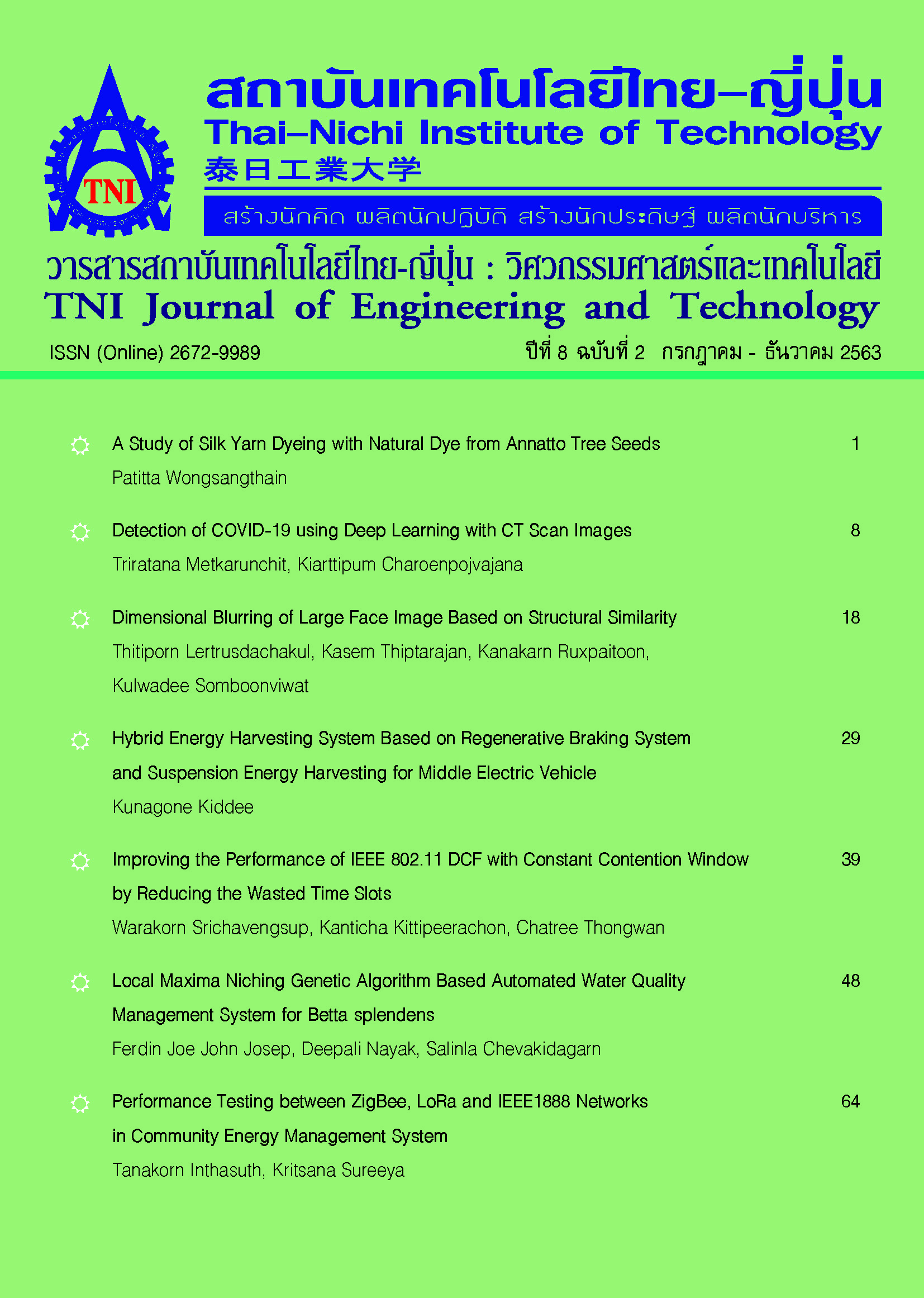การตรวจหา COVID-19 โดยใช้การเรียนรู้เชิงลึกกับภาพซีทีสแกน
Main Article Content
บทคัดย่อ
การตรวจหาผู้ที่คาดว่าจะเป็น “ไวรัสโคโรนาสายพันธุ์ใหม่” หรือ COVID-19 นั้นมีความต้องการเพิ่มขึ้นเรื่อย ๆ อย่างมาก เนื่องจากการแพร่ระบาดยังคงดำเนินอยู่ต่อเนื่องและรุนแรงในหลายประเทศ การตรวจคัดกรองโรคที่นิยมใช้โดยทั่วไปคือการตรวจสารพันธุกรรมของไวรัส โดยใช้วิธีการทดสอบแบบ ปฏิกิริยาลูกโซ่พอลิเมอเรสแบบย้อนกลับ (reverse transcription - polymerase chain reaction : RT-PCR) ไม่นานมานี้ได้เริ่มมีการวินิจฉัยโรค COVID-19 ด้วยภาพรังสีเอกซ์ทรวงอก (chest X-rays) เป็นวิธีที่ง่ายกว่าและมีความสำคัญในสถานการณ์แบบนี้ โดยเฉพาะอย่างยิ่งการนำมาใช้ร่วมกับการเรียนรู้เชิงลึก (deep learning) ที่มีการรู้จำและจำแนกภาพ โดยสามารถตรวจจับความผิดปรกติของเนื้อเยื่อปอด (lung parenchyma) ที่เป็นลายเซ็นเฉพาะของไวรัส COVID-19 ได้อย่างมีประสิทธิภาพและรวดเร็ว บทความนี้มีวัตถุประสงค์เพื่อประยุกต์ใช้ หน้ากากแยกบริเวณคอนโวลูชันโครงข่ายประสาทเทียม (mask region-based convolutional neural networks : Mask RCNN) แยกส่วนบริเวณเนื้อเยื่อที่ได้รับผลกระทบจากไวรัส จากภาพถ่ายรังสีส่วนตัดอาศัยคอมพิวเตอร์ (computed tomography : CT) ทรวงอก การทำนายบริเวณเนื้อเยื่อปอดที่ได้รับความเสียหาย จะช่วยให้แพทย์จำแนกสภาพของผู้ป่วยได้ว่ามีอาการ "ไม่รุนแรง" หรือ "น่ากลัว" ได้ง่ายขึ้น จากผลการทดสอบแบบจำลองที่ประมวลผลบนกูเกิ้ลคลาวด์แพลตฟอร์ม (google cloud platform) แบบจำลองนี้ได้คะแนน F1 เท่ากับ 89% และมีค่าเฉลี่ยความเร็วในการอนุมานอยู่ที่ 9.71 วินาที
Article Details
นโยบายการรับบทความ
กองบรรณาธิการวารสารสถาบันเทคโนโลยีไทย-ญี่ปุ่น มีความยินดีรับบทความจากอาจารย์ประจำ และผู้ทรงคุณวุฒิในสาขาวิศวกรรมศาสตร์และเทคโนโลยี ที่เขียนเป็นภาษาไทยหรือภาษาอังกฤษ ซึ่งผลงานวิชาการที่ส่งมาขอตีพิมพ์ต้องไม่เคยเผยแพร่ในสิ่งพิมพ์อื่นใดมาก่อน และต้องไม่อยู่ในระหว่างการพิจารณาของวารสารอื่นที่นำส่ง ดังนั้นผู้สนใจที่จะร่วมเผยแพร่ผลงานและความรู้ที่ศึกษามาสามารถนำส่งบทความได้ที่กองบรรณาธิการเพื่อเสนอต่อคณะกรรมการกลั่นกรองบทความพิจารณาจัดพิมพ์ในวารสารต่อไป ทั้งนี้บทความที่สามารถเผยแพร่ได้ประกอบด้วยบทความวิจัย ผู้สนใจสามารถศึกษาและจัดเตรียมบทความจากคำแนะนำสำหรับผู้เขียนบทความ
การละเมิดลิขสิทธิ์ถือเป็นความรับผิดชอบของผู้ส่งบทความโดยตรง บทความที่ได้รับการตีพิมพ์ต้องผ่านการพิจารณากลั่นกรองคุณภาพจากผู้ทรงคุณวุฒิและได้รับความเห็นชอบจากกองบรรณาธิการ
ข้อความที่ปรากฏภายในบทความของแต่ละบทความที่ตีพิมพ์ในวารสารวิชาการเล่มนี้ เป็น ความคิดเห็นส่วนตัวของผู้เขียนแต่ละท่าน ไม่เกี่ยวข้องกับสถาบันเทคโนโลยีไทย-ญี่ปุ่น และคณาจารย์ท่านอื่น ๆ ในสถาบัน แต่อย่างใด ความรับผิดชอบด้านเนื้อหาและการตรวจร่างบทความแต่ละบทความเป็นของผู้เขียนแต่ละท่าน หากมีความผิดพลาดใด ๆ ผู้เขียนแต่ละท่านจะต้องรับผิดชอบบทความของตนเองแต่ผู้เดียว
กองบรรณาธิการขอสงวนสิทธิ์มิให้นำเนื้อหา ทัศนะ หรือข้อคิดเห็นใด ๆ ของบทความในวารสารสถาบันเทคโนโลยีไทย-ญี่ปุ่น ไปเผยแพร่ก่อนได้รับอนุญาตจากผู้นิพนธ์ อย่างเป็นลายลักษณ์อักษร ผลงานที่ได้รับการตีพิมพ์ถือเป็นลิขสิทธิ์ของวารสารสถาบันเทคโนโลยีไทย-ญี่ปุ่น
ผู้ประสงค์จะส่งบทความเพื่อตีพิมพ์ในวารสารวิชาการ สถาบันเทคโนโลยีไทย-ญี่ปุ่น สามารถส่ง Online ที่ https://www.tci-thaijo.org/index.php/TNIJournal/ โปรดสมัครสมาชิก (Register) โดยกรอกรายละเอียดให้ครบถ้วนหากต้องการสอบถามข้อมูลเพิ่มเติมที่
- กองบรรณาธิการ วารสารสถาบันเทคโนโลยีไทย-ญี่ปุ่น
- ฝ่ายวิจัยและนวัตกรรม สถาบันเทคโนโลยีไทย-ญี่ปุ่น
เลขที่ 1771/1 สถาบันเทคโนโลยีไทย-ญี่ปุ่น ซอยพัฒนาการ 37-39 ถนนพัฒนาการ แขวงสวนหลวง เขตสวนหลวง กรุงเทพมหานคร 10250 ติดต่อกับคุณพิมพ์รต พิพัฒนกุล (02) 763-2752 , คุณจุฑามาศ ประสพสันติ์ (02) 763-2600 Ext. 2402 Fax. (02) 763-2754 หรือ E-mail: JEDT@tni.ac.th
References
World Health Organization, “WHO coronavirus disease (COVID-19) dashboard,” Accessed: Nov. 10, 2020. [Online]. Available: https://covid19.who.int
F. Pan, T. Ye, P. Sun, S. Gui, B. Liang, L. Li, D. Zheng, J. Wang, R. L. Hesketh, L. Yang, and C. Zheng, “Time course of lung changes at chest CT during recovery from coronavirus disease 2019 (COVID-19),” Radiology, vol. 295, no.3, pp. 715–721, 2020.
S. Basu, S. Mitra, and N. Saha, “Deep learning for screening COVID-19 using chest X-ray Images,” 2020. [Online]. Available: arXiv:2004.10507.
S. Latif, J. Qadir, S. Farooq, and M. A. Imran, “How 5G wireless (and concomitant technologies) will revolutionize healthcare?,” Future Internet, vol. 9, no. 4, pp. 1-24, 2017.
Y. Wang, C. Dong, Y. Hu, C. Li, Q. Ren, X. Zhang, H. Shi, and M. Zhou, “Temporal changes of CT findings in 90 patients with COVID-19 pneumonia:A longitudinal study,” Radiology, vol. 296, no. 2, pp. E55-E64, Mar, 2020.
J. L. He, L. Luo, Z. D. Luo, J. X. Lyu, M. Y. Ng, X. P. Shen, and Z. Wen, “Diagnostic performance between CT and initial real-time RT-PCR for clinically suspected 2019 coronavirus disease (COVID-19) patients outside Wuhan, China,” Respiratory Medicine, vol. 168, pp. 1-5, Apr. 2020.
S. C. Shelmerdine, J. Lovrenski, P. C. Domínguez, and S. Toso, “Coronavirus disease 2019 (COVID-19) in children: A systematic review of imaging findings,” Pediatric Radiology, vol. 50, no. 9, pp. 1217–1230, Jun, 2020.
G. Maguolo and L. Nanni, “A critic evaluation of methods for COVID-19 automatic detection from x-ray images,” 2020. [Online]. Available: arXiv:2004.12823.
F. Shan, Y. Gao, J. Wang, W. Shi, N. Shi, M. Han, Z. Xue, and Y. Shi, “Lung infection quantification of COVID-19 in CT images with deep learning,” 2020. [Online]. Available: arXiv:2003.04655.
K. He, G. Gkioxari, P. Dollár, and R. Girshick, “Mask R-CNN,” 2018. [Online]. Available: arXiv:1703.06870.
M. Aleem, R. Raj, and A. Khan, “Comparative performance analysis of the ResNet backbones of mask RCNN to segment the signs of COVID-19 in chest CT scans,” 2020. [Online]. Available: arXiv:2008.09713.
J. P. Cohen, P. Morrison, L. Dao, K. Roth, T. Q. Duong, and M. Ghassemi, “COVID-19 image data collection: Prospective predictions are the future,” 2020. [Online]. Available: arXiv:2006.11988.
COVID-19 Database, Società Italiana di Radiologia, Nov. 2020. [Online]. Available: https://www.sirm.org/category/senza-categoria/covid-19
A. Dutta, A. Gupta, and A. Zisserman. VGG Image Annotator. (2020). Access: Nov. 10, 2020. [Online]. Available: http://www.robots.ox.ac.uk/~vgg/software/via

